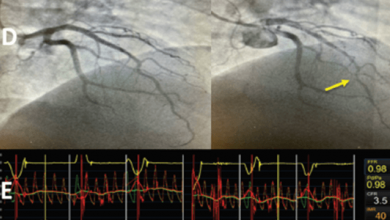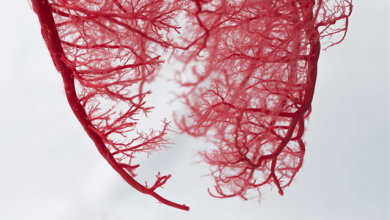Search results
Author(s):
Jun Hua Chong
,
Arjun K Ghosh
Added:
3 years ago
Cardiovascular disease is the leading cause of morbidity and mortality worldwide.1 The WHO estimates that 17 million people die each year of cardiovascular disease, about 30% of all deaths.2 Cancer is the second leading cause of death globally and is associated with 9 million deaths each year.3 According to the WHO, the incidence of cancer is expected to rise by about 70% over the next 20 years.4…
View more
Author(s):
Tom Ford
,
Colin Berry
Added:
3 years ago
Ischaemic heart disease persists as the leading global cause of death and lost life years in adults.1 Angina is a common clinical presentation of ischaemic heart disease related to a supply:demand mismatch of myocardial blood flow, typically provoked by exertion or stress. Invasive coronary angiography is the reference test for angina and identifies obstructive coronary artery disease (CAD) as a…
View more
Author(s):
Robert Sykes
,
Daniel Doherty
,
Kenneth Mangion
,
et al
Added:
2 years ago
Author(s):
Daniel Tze Yee Ang
,
Colin Berry
Added:
2 years ago
‘Primary’ Microvascular Angina
Author(s):
Gaetano Antonio Lanza
,
Juan Carlos Kaski
Added:
3 years ago
Article
OCT in MINOCA
Author(s):
Grigoris V Karamasis
,
Iosif Xenogiannis
,
Charalampos Varlamos
,
et al
Added:
1 year ago
Article
Author(s):
Paolo Sbarzaglia
,
Salvatore Notaristefano
,
Claudio Cavallini
Added:
3 years ago
Saphenous vein grafts (SVG) have been extensively used in coronary artery bypass surgery (CABG) as additional conduits to arterial grafts. However, it is well known that vein grafts may develop degenerative processes that may result in stenosis or occlusion1 in 12–20% of patients at the end of the first year and approximately 50% by 10 years.2 The main causes of graft disease are intimal…
View more
Author(s):
Phyo Htet Khaing
,
G Louise Buchanan
,
Vijay Kunadian
Added:
3 years ago
Many profound physiological changes take place in the cardiovascular system during pregnancy to meet the increased metabolic demands of both the mother and foetus. Such changes include an increase in circulating blood volume and cardiac output and decreases in systemic vascular resistance, blood pressure and hypercoagulation.1,2 The increase in circulatory burden during pregnancy and the…
View more
Author(s):
Vikas Kapil
,
Ajay K Jain
,
Melvin D Lobo
Added:
3 years ago
Up to one-in-five treated hypertensive patients are deemed to be treatment resistant1-3 (on at least three different anti-hypertensive medication classes, including a diuretic)4-6 and have high cardiovascular risk.7-9 There is a paucity of high-quality evidence to suggest that the addition of a fourth line (or fifth, sixth line, etc.) medication is likely to bring either hypertension under…
View more
Author(s):
Tanush Gupta
,
Michael Weinreich
,
Mark Greenberg
,
et al
Added:
3 years ago
Percutaneous coronary intervention (PCI) is the most commonly used revascularisation modality for obstructive coronary artery disease.1 Despite significant advances in PCI over the past 40 years, severe coronary calcification remains a challenge for successful PCI.2,3 Up to 20% of patients undergoing PCI are estimated to have moderate to severe coronary calcification.4,5
Heavily calcified…
View more
















